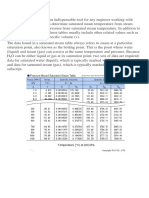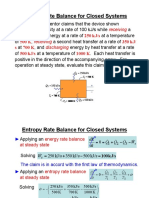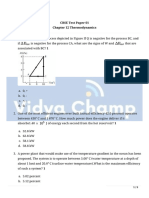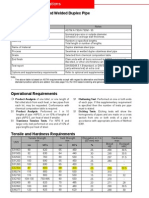CH2010 Chemical Engineering Thermodynamics Assignment - 2
CH2010 Chemical Engineering Thermodynamics Assignment - 2
Uploaded by
Aryan PandeyCopyright:
Available Formats
CH2010 Chemical Engineering Thermodynamics Assignment - 2
CH2010 Chemical Engineering Thermodynamics Assignment - 2
Uploaded by
Aryan PandeyOriginal Title
Copyright
Available Formats
Share this document
Did you find this document useful?
Is this content inappropriate?
Copyright:
Available Formats
CH2010 Chemical Engineering Thermodynamics Assignment - 2
CH2010 Chemical Engineering Thermodynamics Assignment - 2
Uploaded by
Aryan PandeyCopyright:
Available Formats
CH2010
Chemical Engineering Thermodynamics
Assignment-‐2
Date: 20.09.2018
1. In a closed vessel, 3 kJ of work is done on 2 moles of a gas by some series of irreversible
operations. In this process, pressure increases from 10 bar to 20 bar and temperature from
300 K to 320 K. The gas obeys the equation of state: P(v – b) = RT, where b = 5x10-5
m3/mol. At 10 bar over the temperature range of interest, the specific heat capacity of the gas
at constant volume can be calculated as Cv = 0.1 T (where T is in K).
(a) Calculate the net heat interaction of the given system with the environment.
(b) Determine the change of enthalpy ΔH and change of Helmholtz free energy ΔA for the
system mentioned above.
2. In an isentropic process, an oxygen gas at 150 K is compressed from 30 bar to 100 bar with
an efficiency of 80%. Estimate the power required for the compressor if the gas flow rate is
10 kg/s. Assume that the above system obeys the Peng-Robinson equation of state with
Tc = 154.6 K, Pc = 50.46 bar, Cp = 29.3 J/mol K and an acentric factor of 0.021.
3. In an enhanced oil recovery operation, an adiabatically compressed CO2 is cooled at constant
pressure and then flooded into an oil-bearing reservoir encased with steel pipe as given in
below figure. Estimate the work and cooling requirements of CO2 with T0 = 25 °C while
assuming that the CO2 obeys van der Waals EOS.
Specific heat of CO2 at constant pressure is given as (T is in K):
𝐶!! 𝑇 = 𝑎 + 𝑏𝑇 + 𝑐𝑇 ! + 𝑑𝑇 ! 𝐽 𝑚𝑜𝑙 𝐾 ,
where a = 19.8, b = 0.07344, c = 0.5602 x 10-4, d = 1.715 x 10-8.
!"#!
4. The vapor pressure of liquid ammonia near the triple point isgiven by 𝑙𝑛𝑃 = 24.38 − !
which is the equation of liquid-vapor boundary curve in a P-T diagram, where P is in Pa,
!"#$
Similarly, vapor pressure of solid ammonia is given as 𝑙𝑛𝑃 = 27.92 − !
, where P is in Pa.
Estimate/Determine the following:
i) Temperature and pressure at triple point
ii) Latent heats of sublimation and vaporization
iii) Latent heat of fusion at the triple point
5. A constant latent heat of vaporization of 5×10! 𝐽 𝑚𝑜𝑙 exists along the coexistence curve for
a particular material. Consider one mole of this material is in a liquid-vapor equilibrium at
300K and 105 Pa. On heating at constant volume V of 0.01 m3, system pressure increases to
2×10! 𝑃𝑎 (Note that this is not a small ΔP). Find the initial and final mole fractions of vapor
!!
phase (𝑥 ≡ ! )
! !!!
Assume the following,
• Vapor phase is mono-atomic ideal gas
• Molar volume of liquid is much lower than the Molar volume of gas
You might also like
- PTX R 410A Series NewDocument112 pagesPTX R 410A Series NewMohamed Fathi33% (15)
- 94-0518-4 Mini-RadaScan Engineers and Service GuideDocument15 pages94-0518-4 Mini-RadaScan Engineers and Service GuideAlex Sandoval100% (1)
- HW1Document4 pagesHW1Andrés Vodopivec KuriNo ratings yet
- Friction - Thrust Bearings (Numericals)Document17 pagesFriction - Thrust Bearings (Numericals)A Rehman RiazNo ratings yet
- ETD Question Bank 2021-22Document14 pagesETD Question Bank 2021-22Vinay KorekarNo ratings yet
- TEMA 1 Actividad 1 PROBLEMARIO1de3Document1 pageTEMA 1 Actividad 1 PROBLEMARIO1de3Kari BustamanteNo ratings yet
- Exam I - SolutionsDocument34 pagesExam I - Solutionshy2023056744No ratings yet
- Thermodynamics Assignment 2 2014Document5 pagesThermodynamics Assignment 2 2014ravikr950% (1)
- Prob Thermo Chp3Document6 pagesProb Thermo Chp3Muhammad FaizanNo ratings yet
- Pertemuan 7 ReviewDocument45 pagesPertemuan 7 ReviewAna Sholikhatus Sa'diyah100% (1)
- Tutorials For ChemicalthermodynamicsDocument20 pagesTutorials For Chemicalthermodynamicselisee tsokezoNo ratings yet
- CHE 1000 e-LEARNING GASES LECTURE NOTES 2024Document41 pagesCHE 1000 e-LEARNING GASES LECTURE NOTES 2024jmusumali47No ratings yet
- THE IDEAL GAS (Topic6)Document18 pagesTHE IDEAL GAS (Topic6)Ted Mana-ayNo ratings yet
- BT Hoa Ly 1Document22 pagesBT Hoa Ly 1Minh ThưNo ratings yet
- 5 Temp Ideal Gas-Fall 2022Document22 pages5 Temp Ideal Gas-Fall 2022asakr8481No ratings yet
- Agus Haryanto Agreng Dept. 06 MARET 2008Document41 pagesAgus Haryanto Agreng Dept. 06 MARET 2008Cola JamNo ratings yet
- THERMODocument2 pagesTHERMOcarlNo ratings yet
- 6bab Iv (Cont'd)Document40 pages6bab Iv (Cont'd)Muhammad Randy AkbarNo ratings yet
- GisselaBonilla ADocument13 pagesGisselaBonilla AGissela BTNo ratings yet
- hw3 PDFDocument2 pageshw3 PDFRohit SharmaNo ratings yet
- Assignment 2Document5 pagesAssignment 2SouravNo ratings yet
- Gas LawsDocument31 pagesGas Lawsapi-546066323No ratings yet
- Contoh Soal Termo - Tk.Document17 pagesContoh Soal Termo - Tk.dit doankNo ratings yet
- Taller Fisicoquimica TermoDocument6 pagesTaller Fisicoquimica TermoWilo JaraNo ratings yet
- HW-04Document2 pagesHW-04jorge isaiasNo ratings yet
- W-5, Chap.3-Properties of Pure Substances-3Document32 pagesW-5, Chap.3-Properties of Pure Substances-3سيمو بشيريNo ratings yet
- Problems 2 1st Law PDFDocument10 pagesProblems 2 1st Law PDFKrystel Monica Manalo0% (1)
- Gas Properties and Laws NotesDocument4 pagesGas Properties and Laws NotesAlAr-JohnTienzoTimeniaNo ratings yet
- A2 53b GasesDocument50 pagesA2 53b GasesHany ElGezawyNo ratings yet
- HW 03 SolutionsDocument12 pagesHW 03 Solutionsniccolo50% (2)
- Tutorial 3Document2 pagesTutorial 3masungabraidenNo ratings yet
- ثرموداينمكDocument10 pagesثرموداينمكabdcivilNo ratings yet
- ExercisesDocument3 pagesExercisesCarlos Madera SarmientoNo ratings yet
- Heat and Thermodynamics-SubjectiveDocument8 pagesHeat and Thermodynamics-SubjectiveNeeraj KalraNo ratings yet
- AE-664A Assignment 1Document2 pagesAE-664A Assignment 1Saurav SonawaneNo ratings yet
- Behavior of Pure Substances: Than One Phase, But Each Phase Must Have The Same Chemical CompositionDocument18 pagesBehavior of Pure Substances: Than One Phase, But Each Phase Must Have The Same Chemical CompositionDharmesh PatelNo ratings yet
- Refrigerant 134a in A Piston-Cylinder AssembliesDocument10 pagesRefrigerant 134a in A Piston-Cylinder AssembliescesardakoNo ratings yet
- Tarea 5 TermodinamicaDocument4 pagesTarea 5 TermodinamicaMario GonzalezNo ratings yet
- TDCE Question Bank - 2018 Unit IDocument11 pagesTDCE Question Bank - 2018 Unit IvinodNo ratings yet
- The Gas Laws: Factsheet PhysicsDocument4 pagesThe Gas Laws: Factsheet PhysicsMuhammad DanialNo ratings yet
- TOPIC 1 Physical ChemistryDocument65 pagesTOPIC 1 Physical ChemistrySurendra Louis DupuisNo ratings yet
- KKKR2383 Example Questions For Chapter I PDFDocument4 pagesKKKR2383 Example Questions For Chapter I PDFmasmashitahNo ratings yet
- Ideal GasesDocument19 pagesIdeal GasesTheLeaderDimitriosNo ratings yet
- Wen FengDocument22 pagesWen Fengdueltmpotc8wNo ratings yet
- Homework 1Document4 pagesHomework 1Itzel A. GuerreroNo ratings yet
- Entropy Rate Balance For Closed Systems: ExampleDocument26 pagesEntropy Rate Balance For Closed Systems: ExampleDaniel García100% (1)
- Lab Session 9, Experiment 8: Calorimetry, Heat of ReactionDocument7 pagesLab Session 9, Experiment 8: Calorimetry, Heat of ReactionFatin IziantiNo ratings yet
- Work Sheet1Document4 pagesWork Sheet1Tesfa negaNo ratings yet
- The Equation of State For A Perfect Gas: A. Boyle'S LawDocument9 pagesThe Equation of State For A Perfect Gas: A. Boyle'S LawCzarina Jane PeregrinNo ratings yet
- 23mee202et Questionbooklet-2Document7 pages23mee202et Questionbooklet-2rethinagiriswaransheshanthNo ratings yet
- Tutorial 1 PDFDocument4 pagesTutorial 1 PDFSagar AddepalliNo ratings yet
- 1Document2 pages1Bình TĩnhNo ratings yet
- Thermodynamics Practice Problems 3Document13 pagesThermodynamics Practice Problems 3Minh Trương PhúcNo ratings yet
- ESO201A Tutorial 3Document17 pagesESO201A Tutorial 3Arnav HarshitNo ratings yet
- Assignment 4Document3 pagesAssignment 4Saurabh BhimwalNo ratings yet
- Ideal Gas Equation and EntropyDocument27 pagesIdeal Gas Equation and EntropyJude Roswel GenerilloNo ratings yet
- THE IDEAL GAS (Topic6)Document17 pagesTHE IDEAL GAS (Topic6)ch0k3 iiiNo ratings yet
- Problem Sheet 1 Basics and TemperatureDocument4 pagesProblem Sheet 1 Basics and TemperatureS DNo ratings yet
- Hw1phys2 2019Document3 pagesHw1phys2 2019jiddagerNo ratings yet
- CBSE Test Paper 01 Chapter 12 ThermodynamicsDocument9 pagesCBSE Test Paper 01 Chapter 12 Thermodynamicschoudharysaksham.c77No ratings yet
- A Modern Course in Statistical PhysicsFrom EverandA Modern Course in Statistical PhysicsRating: 3.5 out of 5 stars3.5/5 (2)
- Bonds: Dong Lou London School of Economics LSE Summer SchoolDocument45 pagesBonds: Dong Lou London School of Economics LSE Summer SchoolAryan PandeyNo ratings yet
- Lecture 3 - Portfolio Theory PDFDocument41 pagesLecture 3 - Portfolio Theory PDFAryan PandeyNo ratings yet
- ValvesDocument3 pagesValvesAryan PandeyNo ratings yet
- Dronesbook Chapter2 PDFDocument29 pagesDronesbook Chapter2 PDFAryan PandeyNo ratings yet
- Team Name: Nature's KnightsDocument3 pagesTeam Name: Nature's KnightsAryan PandeyNo ratings yet
- Team Iit Madras Ixl Olympics Fall 2020Document16 pagesTeam Iit Madras Ixl Olympics Fall 2020Aryan PandeyNo ratings yet
- Team Iit Madras Ixl Olympics Fall 2020Document15 pagesTeam Iit Madras Ixl Olympics Fall 2020Aryan PandeyNo ratings yet
- The Capm: Dong Lou London School of Economics LSE Summer SchoolDocument39 pagesThe Capm: Dong Lou London School of Economics LSE Summer SchoolAryan PandeyNo ratings yet
- Drone Other Nations Regulatory Analysis PDFDocument2 pagesDrone Other Nations Regulatory Analysis PDFAryan PandeyNo ratings yet
- Microsoft ML/Data-Science Profile Test ShortlistDocument4 pagesMicrosoft ML/Data-Science Profile Test ShortlistAryan PandeyNo ratings yet
- IXL PPTDocument15 pagesIXL PPTAryan PandeyNo ratings yet
- Investment Management: CAFTA WebinarDocument38 pagesInvestment Management: CAFTA WebinarAryan PandeyNo ratings yet
- NIMF Monthly Portfolio Aug 2020Document588 pagesNIMF Monthly Portfolio Aug 2020Aryan PandeyNo ratings yet
- Citi Job Specification: Job Title: Business: DivisionDocument2 pagesCiti Job Specification: Job Title: Business: DivisionAryan PandeyNo ratings yet
- Case Study Solution - Portfolio AllocationDocument45 pagesCase Study Solution - Portfolio AllocationAryan PandeyNo ratings yet
- Wind Tunnel Fac. in IndiaDocument7 pagesWind Tunnel Fac. in IndiaAryan PandeyNo ratings yet
- CH2010 Chemical Engineering Thermodynamics Assignment - 2Document2 pagesCH2010 Chemical Engineering Thermodynamics Assignment - 2Aryan PandeyNo ratings yet
- Wind Tunnel Fac. in IndiaDocument7 pagesWind Tunnel Fac. in IndiaAryan PandeyNo ratings yet
- Corporate Citizenship ReportDocument23 pagesCorporate Citizenship ReportAryan PandeyNo ratings yet
- BPP Risk Assessment PDFDocument1 pageBPP Risk Assessment PDFAryan PandeyNo ratings yet
- Plascore SelectorhoneycombDocument1 pagePlascore SelectorhoneycombAryan PandeyNo ratings yet
- Assignment 4Document1 pageAssignment 4Aryan PandeyNo ratings yet
- E Kinedizer I SpecsDocument7 pagesE Kinedizer I SpecstechdocuNo ratings yet
- Takehome ActivityDocument5 pagesTakehome ActivityEdmond Yurag LLusalaNo ratings yet
- Re27551 - 2020 11 04Document12 pagesRe27551 - 2020 11 04MSc Kostic MilosNo ratings yet
- Microsoft PowerPoint - WeldingDocument42 pagesMicrosoft PowerPoint - WeldingGOBLIN XXXNo ratings yet
- Manual de Partes Productos Clase 3Document224 pagesManual de Partes Productos Clase 3Jre ECNo ratings yet
- ZMR ApiDocument121 pagesZMR ApiRaheem_kaNo ratings yet
- KYTE Pumping Unit Introduction 20210415Document8 pagesKYTE Pumping Unit Introduction 20210415wilson povedaNo ratings yet
- ToolsDocument28 pagesToolschutneynkunikeniNo ratings yet
- PGP/PGM600: Service ManualDocument20 pagesPGP/PGM600: Service ManualARTMehr Eng. GroupNo ratings yet
- Material Stream: Sulfinol: ConditionsDocument2 pagesMaterial Stream: Sulfinol: ConditionsFmuharIrolNo ratings yet
- Data Sheet Hvac System For Aradh Control Building ER-3148 Hawiyah Gas Development PipelinesDocument7 pagesData Sheet Hvac System For Aradh Control Building ER-3148 Hawiyah Gas Development Pipelinesari78No ratings yet
- Lovol - Engine - Catalogue - IEP Power (FILTERS, PARTS, DATASHEET, CURVES)Document32 pagesLovol - Engine - Catalogue - IEP Power (FILTERS, PARTS, DATASHEET, CURVES)Wilson SuárezNo ratings yet
- Mercedes Transmission OverviewDocument12 pagesMercedes Transmission OverviewMoez Karoui100% (1)
- Moventas PH2900.2 - FinésDocument13 pagesMoventas PH2900.2 - FinésDaniel Fuhr100% (1)
- SDH2-Chapter 14-Design of Structures With Seismic Isolation PDFDocument34 pagesSDH2-Chapter 14-Design of Structures With Seismic Isolation PDFhangarrodNo ratings yet
- "South Mahakam": GD Duplex 4"X5" FF-FXF Cap 94.4 GPM (2751B/D)Document3 pages"South Mahakam": GD Duplex 4"X5" FF-FXF Cap 94.4 GPM (2751B/D)Nurul Fitri RasyidNo ratings yet
- Research Proposal Biped Robot: Mechanical Engineering DepartmentDocument20 pagesResearch Proposal Biped Robot: Mechanical Engineering DepartmentAshish MajithiaNo ratings yet
- 13-Airvent Valve (Valmatic) - (Catalouge & Certificate)Document7 pages13-Airvent Valve (Valmatic) - (Catalouge & Certificate)Engr. Melon SharkerNo ratings yet
- A790 PDFDocument2 pagesA790 PDFrizairawan09No ratings yet
- Condensate Transportation PumpDocument22 pagesCondensate Transportation PumpKARTHIKEYANNo ratings yet
- Perkins 1300Document2 pagesPerkins 1300ahmedalgalo50% (2)
- Lagrange Equation and It's ApplicationsDocument6 pagesLagrange Equation and It's ApplicationsAsish SwainNo ratings yet
- 100T Cap Crane - 3Document27 pages100T Cap Crane - 3mekasriharsha4No ratings yet
- ASME PTC 25-2001 Pressure Relief Devices PDFDocument90 pagesASME PTC 25-2001 Pressure Relief Devices PDFSaid HappyyNo ratings yet
- Lifting Plan For Off-Loading of Tanks at Mazari YardDocument9 pagesLifting Plan For Off-Loading of Tanks at Mazari Yardmeshahan100% (1)
- IPE FinalsDocument3 pagesIPE FinalsArtz unayNo ratings yet
- Pile Foundations (7) - 5th SEMDocument4 pagesPile Foundations (7) - 5th SEMDipankar Nath100% (1)















































































































